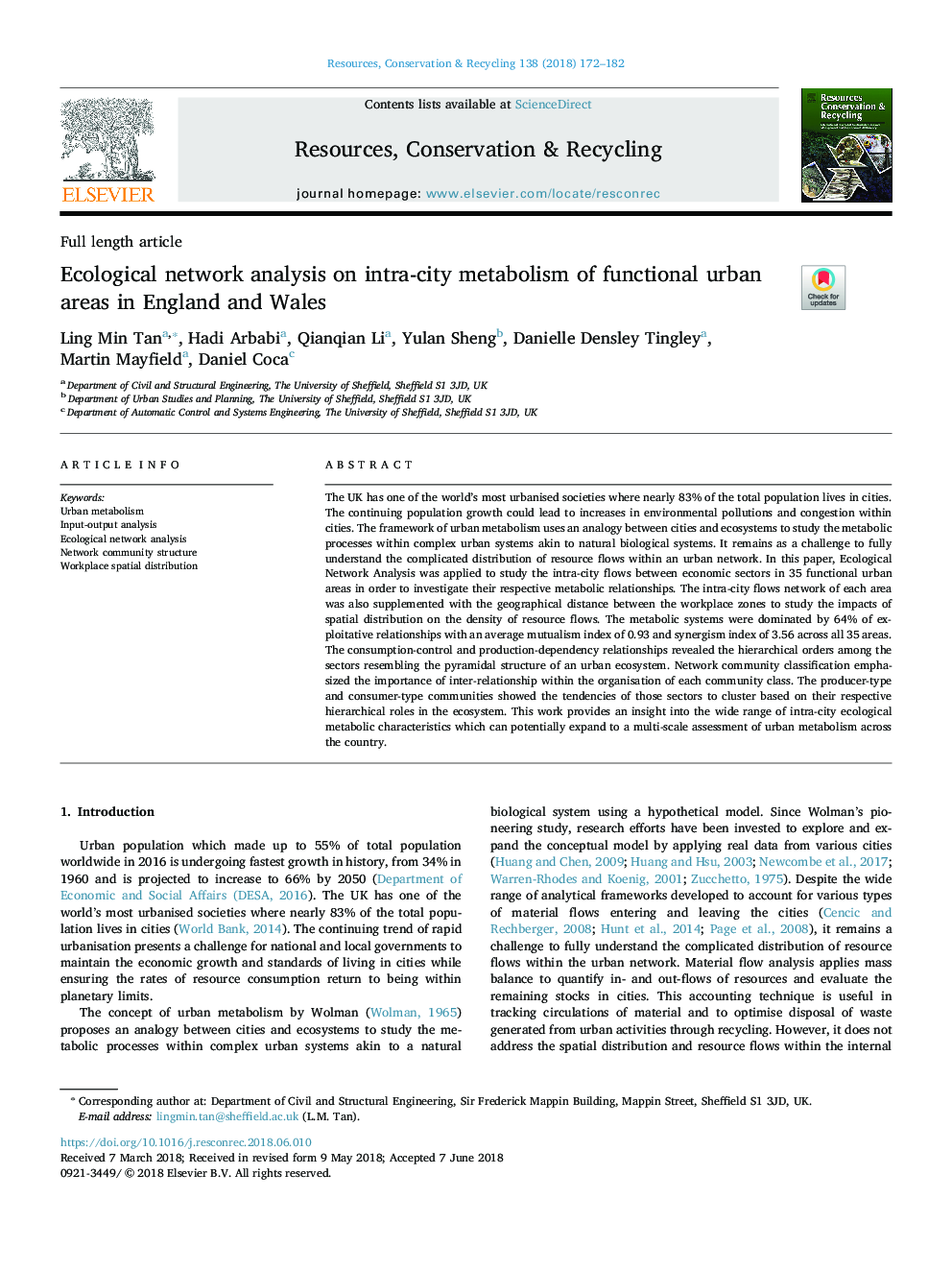| کد مقاله | کد نشریه | سال انتشار | مقاله انگلیسی | نسخه تمام متن |
|---|---|---|---|---|
| 7493820 | 1485654 | 2018 | 11 صفحه PDF | دانلود رایگان |
عنوان انگلیسی مقاله ISI
Ecological network analysis on intra-city metabolism of functional urban areas in England and Wales
ترجمه فارسی عنوان
تجزیه و تحلیل شبکه محیط زیست در متابولیسم داخل شهر مناطق شهری فعال در انگلستان و ولز
دانلود مقاله + سفارش ترجمه
دانلود مقاله ISI انگلیسی
رایگان برای ایرانیان
کلمات کلیدی
متابولیسم شهری، تجزیه و تحلیل ورودی-خروجی، تجزیه و تحلیل شبکه محیط زیست، ساختار جامعه شبکه، توزیع فضایی محل کار،
ترجمه چکیده
انگلستان یکی از جوامع شهری جهان است که تقریبا 83 درصد کل جمعیت آن در شهرها زندگی می کنند. ادامه رشد جمعیت می تواند منجر به افزایش آلودگی های زیست محیطی و تراکم در شهرها شود. چارچوب متابولیسم شهری از قیاس بین شهرهای و اکوسیستم ها برای مطالعه فرآیندهای متابولیک در سیستم های پیچیده شهری شبیه به سیستم های بیولوژیکی طبیعی استفاده می کند. به عنوان یک چالش برای به طور کامل درک توزیع پیچیده جریان های منابع در یک شبکه شهری باقی می ماند. در این مقاله، تحلیل شبکه اکولوژیک برای مطالعه جریان درون شهری بین بخش های اقتصادی در 35 فضای شهری کاربردی جهت بررسی روابط متابولیک مربوطه مورد استفاده قرار گرفت. شبکه جریان درون شهری هر منطقه همچنین با فاصله جغرافیایی بین مناطق محل کار برای بررسی تاثیر توزیع فضایی بر تراکم جریان منابع افزوده می شود. سیستم های متابولیک 64 درصد از روابط استثمارگرانه را با میانگین 0.93 شاخص همبستگی و شاخص هم افزایی 3.56 در تمامی 35 ناحیه تحت سلطه قرار دادند. روابط مصرف کنترل و وابستگی به تولید، سفارشات سلسله مراتبی را در میان بخش هایی شبیه ساختار هرمی یک اکوسیستم شهری نشان داد. طبقه بندی جامعه شبکه بر اهمیت ارتباط بین درون سازمان هر کلاس اجتماعی تأکید کرد. جوامع تولید کننده و نوع مصرف کننده، تمایلات این بخش ها را به خوشه بندی بر اساس نقش سلسله مراتبی آنها در اکوسیستم نشان دادند. این کار بینش را در گستره وسیعی از ویژگی های متابولیک محیط زیست داخل شهر که می تواند به طور گسترده ای در ارزیابی متابولیسم شهری در سراسر کشور گسترش یابد، فراهم می کند.
موضوعات مرتبط
مهندسی و علوم پایه
مهندسی انرژی
انرژی های تجدید پذیر، توسعه پایدار و محیط زیست
چکیده انگلیسی
The UK has one of the world's most urbanised societies where nearly 83% of the total population lives in cities. The continuing population growth could lead to increases in environmental pollutions and congestion within cities. The framework of urban metabolism uses an analogy between cities and ecosystems to study the metabolic processes within complex urban systems akin to natural biological systems. It remains as a challenge to fully understand the complicated distribution of resource flows within an urban network. In this paper, Ecological Network Analysis was applied to study the intra-city flows between economic sectors in 35 functional urban areas in order to investigate their respective metabolic relationships. The intra-city flows network of each area was also supplemented with the geographical distance between the workplace zones to study the impacts of spatial distribution on the density of resource flows. The metabolic systems were dominated by 64% of exploitative relationships with an average mutualism index of 0.93 and synergism index of 3.56 across all 35 areas. The consumption-control and production-dependency relationships revealed the hierarchical orders among the sectors resembling the pyramidal structure of an urban ecosystem. Network community classification emphasized the importance of inter-relationship within the organisation of each community class. The producer-type and consumer-type communities showed the tendencies of those sectors to cluster based on their respective hierarchical roles in the ecosystem. This work provides an insight into the wide range of intra-city ecological metabolic characteristics which can potentially expand to a multi-scale assessment of urban metabolism across the country.
ناشر
Database: Elsevier - ScienceDirect (ساینس دایرکت)
Journal: Resources, Conservation and Recycling - Volume 138, November 2018, Pages 172-182
Journal: Resources, Conservation and Recycling - Volume 138, November 2018, Pages 172-182
نویسندگان
Ling Min Tan, Hadi Arbabi, Qianqian Li, Yulan Sheng, Danielle Densley Tingley, Martin Mayfield, Daniel Coca,
